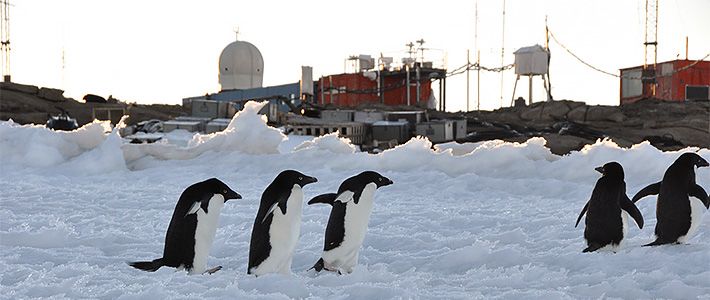
Sixty Years of Antarctic Research: What the Frozen Continent Can Tell Us About the Future of Our Planet
Science Technology- English
- 日本語
- 简体字
- 繁體字
- Français
- Español
- العربية
- Русский
On January 29, 2017, Syōwa Station will celebrate 60 years since it opened as the Japanese research base in Antarctica. A sixtieth birthday is a landmark date in the life of any person or institution. Over the course of those six decades, Japan has steadily carried out scientific research in Antarctica, publishing numerous results. These include many new discoveries that no one could have predicted when work began in Antarctica, as well as a number of important clues for predicting the future of the global environment. As we mark this important anniversary, I want to look back on the history of Japanese Antarctic research, and look at what this tells us about the current state of the environment and the prospects for its future.
 Syōwa Station and the Antarctic Research Vessel Shirase, which will take the next expedition to Antarctica in November 2016.
Syōwa Station and the Antarctic Research Vessel Shirase, which will take the next expedition to Antarctica in November 2016.
Symbol of a New Japan
The story of Japan’s involvement in the Antarctic goes back to 1955, when it announced at a special committee on the International Geophysical Year in Brussels that it planned to begin research in the region. There was apparently deep-rooted opposition among some countries to the idea that Japan was ready to return to the international community so soon after the war. However, other countries were in favor of Japan’s participation, and with their support, Japan started its preparations for Antarctic research.
Although it was already ten years since the war had ended, Japan was still a poor country that bore the scars of its wartime experience. As a child I remember seeing disabled veterans in their hospital uniforms sitting on streets and in front of stations with harmonicas and accordions. It was in this context that a major state project was about to begin.
Yada Kimio, a journalist with the Asahi Shimbun newspaper, learned that the government was considering carrying out research in Antarctica as part of the International Geophysical Year. He persuaded executives at the company to launch an Antarctic Scientific Exploration Project. The whole company got involved in the major campaign that now began, and a major fundraising movement spread across the whole country. Of course, the dedication and hard work of everyone at the Ministry of Education and Culture, the Science Council of Japan, and the Japan Coast Guard (which was responsible for managing the Sōya), were all vital in making the campaign a success. But I am convinced that the passionate support of the Asahi and other private companies and the hopes and dreams of ordinary people around the country were also vital in making the project a reality.
On November 8, 1956, the Antarctic Research Vessel Sōya launched from the Harumi Wharf in Tokyo, waved off by a huge crowd of well-wishers. Japan had joined the United Nations the same year. Many of the people on the wharf that day no doubt saw the ship as a symbol of Japan itself as the country set sail to rejoin the international community. The fact that the launch happened to coincide with Japan’s return to international life made this a highly symbolic event that announced the country’s determination to be reborn as a scientific power.
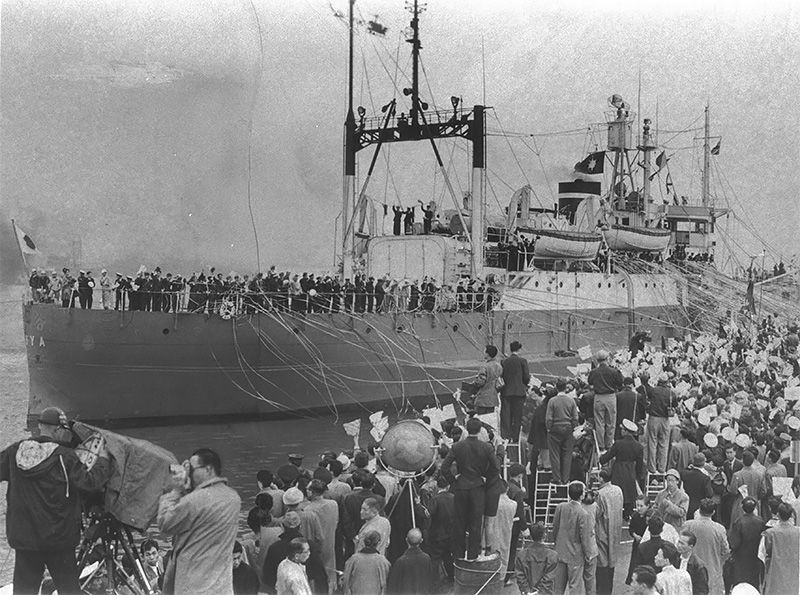 The Sōya gets underway on November 8, 1956.
The Sōya gets underway on November 8, 1956.
The Antarctic Spirit of Cooperation
And so the Sōya set out for Antarctica, carrying with her the hopes of a nation. But once in Antarctica, the ship’s progress was blocked by thick sea ice and blizzards. Although Japan had succeeded in sending a first team of researchers to winter in Antarctica, on the return route the ship became trapped in ice, stuck fast and unable to move.
The Japanese team sent out an SOS to the Soviet icebreaker the Ob, and was lucky enough to be rescued. With the Cold War already underway, relations between Japan and the Soviet Union were barely cordial at the time. But none of this mattered to the researchers involved, and the rescue became a famous example of the Antarctic spirit that says researchers and explorers in the Antarctic must always help one another whenever they can. This spirit of comradeship and cooperation continues to be handed down to the present and is an important part of the lives of the people working in the region today.
The first wintering team consisted of 11 team members under the leadership of Nishibori Eizaburō. The life-threatening risks and near misses the team experienced that winter—as their provisions were swept away from on top of the ice and their research base was destroyed by fire—are chronicled with almost painful clarity in Nishibori’s diaries, later published in Japan under the title Nankyoku ettōki (Wintering in Antarctica: A Personal Record). The remarkable resourcefulness shown by the team as they battled the overwhelming conditions of Antarctic winter , and their determination as they carried out their work and struggled to construct permanent research facilities despite all the setbacks, is a story that has lost none of its power to move.
A Treasure Trove of Meteorite Fragments
The important work of Japanese researchers in Antarctica has brought to light a number of things we should never have known without on-the-scene observation. Let me introduce a few of these briefly.
In 1969, expedition member Yoshida Masaru was working on a study of ice and snow in the interior of the continent when he suddenly came across a black substance in the Yamato Mountains, located approximately 300 kilometers south-southwest of Syōwa Station. Yoshida was a geologist, and knew almost immediately that it was not any type of rock found on earth. When he got back to Japan and studied his finding in more detail, he made a remarkable discovery: the rock was part of a meteorite. Japan began a methodical study on meteorites in the Antarctic shortly after this first discovery. Since then, Japanese researchers have collected a total of 17,000 fragments of meteorite in the Antarctic, as of 2016.
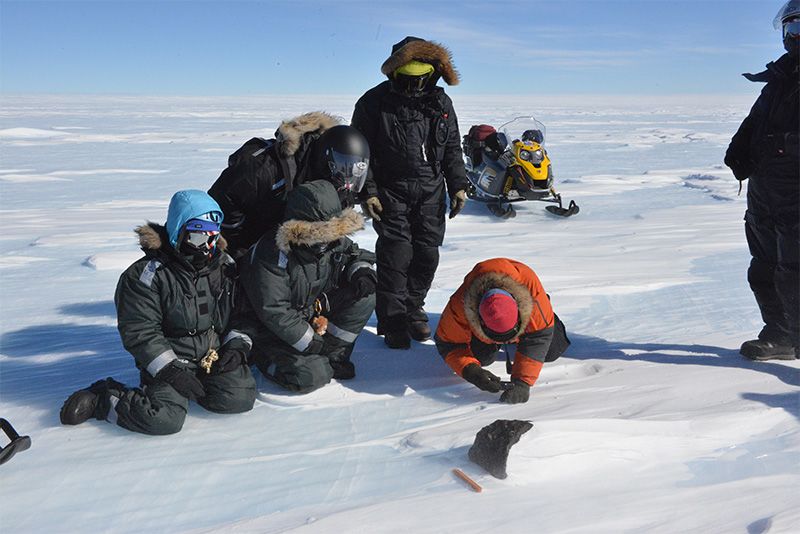 Researchers studying meteorites in the Sør Rondane Mountains in January 2013.
Researchers studying meteorites in the Sør Rondane Mountains in January 2013.
The discovery of meteorites on this huge scale was no coincidence. The Antarctic continent is around 37 times larger than Japan—you wouldn’t expect to stumble across many meteorites just by wandering around at random. Japanese researchers ascertained the mechanism by which meteorites accumulate, and carried out focused surveys based on this knowledge. This led them to the discovery that Antarctica is a treasure trove of meteorites. Japanese researchers were the first to bring this fact to the attention of the world, and this discovery will go down as one of the major contributions of Japan’s work in the Antarctic.
Most of the meteorites found in the Antarctic are believed to originate from asteroids, but some come from the Moon and Mars, and new discoveries are likely to be made in the future. The year 2019 will mark 50 years since the first discovery of meteorites in Antarctica. The following year, 2020, the Japanese space probe Hayabusa 2 will return to earth after its epic mission to collect samples from an asteroid. The discovery of meteorites in Antarctica opened the door to new possibilities for planetary materials science. I look forward to many new discoveries in the field in the years to come
Discovering the Hole in the Ozone Layer
In 1982, Japanese researchers were among the first to discover that the amount of ozone in the atmosphere above Antarctica was decreasing rapidly. According to Chūbachi Shigeru, who was in charge of the observations at the time, the readings were so unusual that initially he suspected there was something wrong with the equipment. After returning home at the end of the winter, Chūbachi reported his findings at the Ozone Symposium in Greece. This was the first report ever to draw attention to the hole in the ozone layer above the Antarctic. To measure the amount of ozone in the atmosphere, a device known as a Dobson spectrophotometer is used. Normally sunlight is required, but Chūbachi made a number of creative modifications to allow him to carry out measurements using moonlight, as sunlight is extremely limited during the polar winter.
The growth of the hole in the ozone was not something that concerned Antarctica alone, but a serious problem for the global environment. A growing understanding of the dangers this posed led to the Montreal Protocol banning substances harmful to the ozone layer, which was agreed in 1987 in Canada and came into force in 1989. Thanks to the effect of this international agreement, the hole in the ozone layer, which at one stage had grown to almost twice the size of the Antarctic continent, has recently started to shrink in size.
The ozone layer plays a vital role in life on earth, stopping harmful ultraviolet rays before they get here. If the ozone layer were ever destroyed, life on the land would no longer be possible, and the only life to survive would be in the oceans or under the ground, in regions where ultraviolet light cannot reach.
Pillars of Moss in Antarctica’s Lakes
In 1995 Imura Satoshi came across a bizarre form of life at the bottom of the lakes above exposed bedrock around Syōwa Station. During research dives in the lakes, he discovered large green towers of plant life around 40 centimeters across and 60 centimeters high. These have been given the name kokebōzu or “moss pillars.” The pyramid-like piles are made up of various lifeforms massing together, including moss, algae, and cyanobacteria, which form clumps at the bottom of the lake.
Even in the depths of the Antarctic winter, the seas and lakes never freeze entirely, and the snow and ice is normally restricted to the surface. Nevertheless, it was a major surprise to find plant life thriving here on such a large scale, almost like a forest on the bottom of the lake. It is fascinating to think about how and when these plants might have made their way here and started to live in the harsh Antarctic environment. The ecology of life in this extreme environment has much to tell us about the origins and evolution of life on earth.
 Installing an underwater video system to observe moss pillars at the bottom of a lake in January 2010.
Installing an underwater video system to observe moss pillars at the bottom of a lake in January 2010.
Time Capsules in the Ice Core
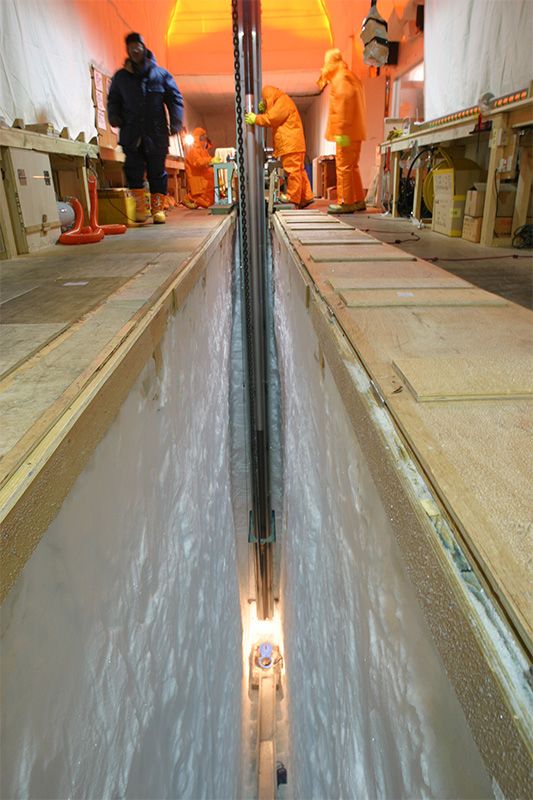 Extracting ice core samples at the Dome Fuji Station deep in the interior of Antarctica in January 2005. The illuminated part shows the drill entering the ice. Researchers excavated samples from 3 kilometers below the surface.
Extracting ice core samples at the Dome Fuji Station deep in the interior of Antarctica in January 2005. The illuminated part shows the drill entering the ice. Researchers excavated samples from 3 kilometers below the surface.
The Antarctic continent is covered with ice sheets that in some places are up to four kilometers thick. The sheets are made up of compacted snow that has fallen over many centuries; the deeper down in the ice sheets you go, the older the ice you find there. At Dome Fuji Station, some 1,000 kilometers from Syōwa Station in the interior of the continent, researchers drilled down 3,035 meters into the ice, almost to the bedrock, and brought up samples of ice that originally fell as snow some 720,000 years ago. These samples are known as “ice cores.” They made it possible for researchers to extract continuous data showing changes in air temperature and carbon dioxide levels over the last 720,000 years. In this sense, the ice cores extracted from deep within the Antarctic ice sheets are like time capsules that can tell us about the past of our planet and environment.
The Dome Fuji Station was opened in 1996. It is situated 3,800 meters above sea level, where the average temperature is minus 50 degrees. In the depths of winter, temperatures can fall as low as minus 80. To establish a research station in a place like this required a large, heavy-duty snow vehicle that was capable of transporting large amounts of materials and equipment and withstanding extremely low temperatures. Most important of all were the drills. After tests in Japan and Greenland, researchers succeeded in developing a drill with the fastest drilling speeds in the world. This kind of technology was essential to the team’s research work—without it, it would never have been possible to dig down so far and bring deep ice core samples to the surface.
What Antarctica Can Tell Us About the Future of Our Planet
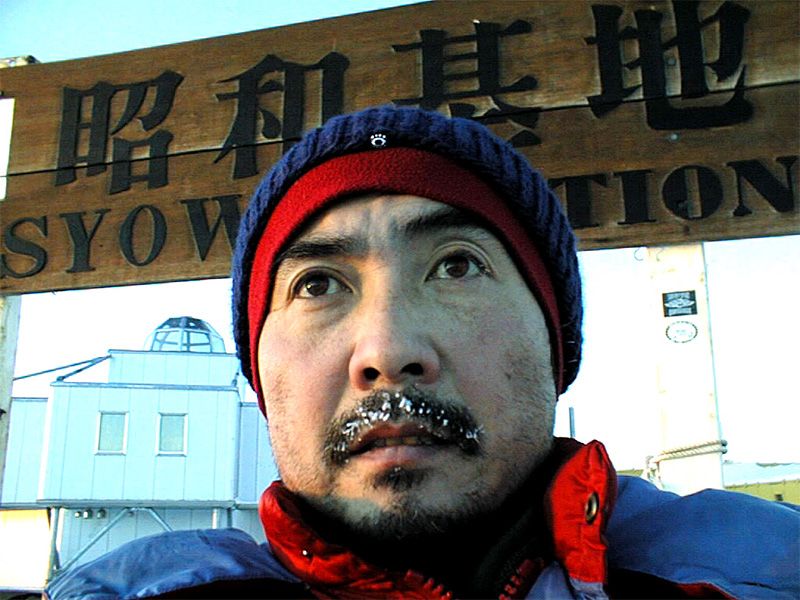 The author in Antarctica in 2001. He has been appointed leader of the next expedition, which will leave for Antarctica in November this year.
The author in Antarctica in 2001. He has been appointed leader of the next expedition, which will leave for Antarctica in November this year.
The Antarctic has been described as a window onto the environment and the wider universe around us. Polar research involves studying changes on a global level and in near-earth space. In particular, it has an important role to play in elucidating the factors causing climate change, and in carrying out scientific observations of relevant changes and fluctuations. The mechanisms of global climate change are anything but straightforward. They involve solar energy, cosmic rays, geomagnetism, plate tectonics, ocean tides, ice sheets, and the activities of all living creatures, among other things. These factors interact in complex ways, all of them having an impact on the earth’s atmosphere, the seas and oceans, and the plant and animal world, as part of a constant chain of reactions. They are also triggers for further change.
The polar regions, where ice sheets, oceans, and land can be studied together as a set, are extremely rare places on our planet and therefore especially important places for scientific research. If anyone asks me what is the point of scientific research in Antarctica, this is my reply: We are working to find scientific data to explain what is happening to the planet on a global level now, and to show what is likely to happen in the years to come. Our work is an essential part of trying to understand the meaning of our existence on this platform we call the earth—part of the timeless quest for an answer to the question of where we have come from and where we are going.
(Originally published in Japanese on October 6, 2016. Banner photo: A group of Adélie penguins pays a visit to Syōwa Station in 2011. All photos courtesy of the National Institute of Polar Research.)